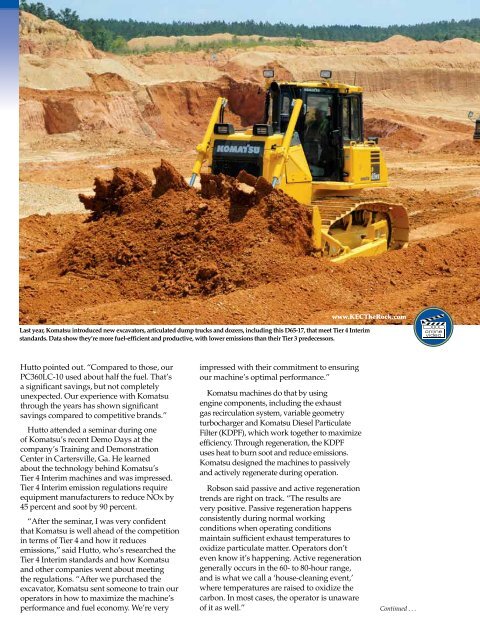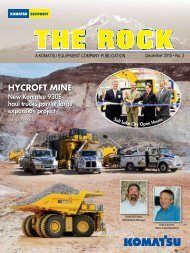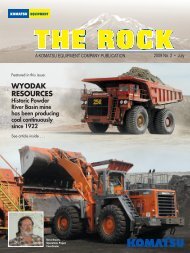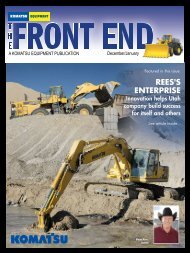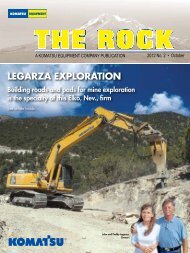ROCKY MOUNTAIN RECYCLING
a PDF version - KEC The Rock Magazine
a PDF version - KEC The Rock Magazine
- No tags were found...
You also want an ePaper? Increase the reach of your titles
YUMPU automatically turns print PDFs into web optimized ePapers that Google loves.
www.KECTheRock.com<br />
Last year, Komatsu introduced new excavators, articulated dump trucks and dozers, including this D65-17, that meet Tier 4 Interim<br />
standards. Data show they’re more fuel-efficient and productive, with lower emissions than their Tier 3 predecessors.<br />
online<br />
video<br />
Hutto pointed out. “Compared to those, our<br />
PC360LC-10 used about half the fuel. That’s<br />
a significant savings, but not completely<br />
unexpected. Our experience with Komatsu<br />
through the years has shown significant<br />
savings compared to competitive brands.”<br />
Hutto attended a seminar during one<br />
of Komatsu’s recent Demo Days at the<br />
company’s Training and Demonstration<br />
Center in Cartersville, Ga. He learned<br />
about the technology behind Komatsu’s<br />
Tier 4 Interim machines and was impressed.<br />
Tier 4 Interim emission regulations require<br />
equipment manufacturers to reduce NOx by<br />
45 percent and soot by 90 percent.<br />
“After the seminar, I was very confident<br />
that Komatsu is well ahead of the competition<br />
in terms of Tier 4 and how it reduces<br />
emissions,” said Hutto, who’s researched the<br />
Tier 4 Interim standards and how Komatsu<br />
and other companies went about meeting<br />
the regulations. “After we purchased the<br />
excavator, Komatsu sent someone to train our<br />
operators in how to maximize the machine’s<br />
performance and fuel economy. We’re very<br />
impressed with their commitment to ensuring<br />
our machine’s optimal performance.”<br />
Komatsu machines do that by using<br />
engine components, including the exhaust<br />
gas recirculation system, variable geometry<br />
turbocharger and Komatsu Diesel Particulate<br />
Filter (KDPF), which work together to maximize<br />
efficiency. Through regeneration, the KDPF<br />
uses heat to burn soot and reduce emissions.<br />
Komatsu designed the machines to passively<br />
and actively regenerate during operation.<br />
Robson said passive and active regeneration<br />
trends are right on track. “The results are<br />
very positive. Passive regeneration happens<br />
consistently during normal working<br />
conditions when operating conditions<br />
maintain sufficient exhaust temperatures to<br />
oxidize particulate matter. Operators don’t<br />
even know it’s happening. Active regeneration<br />
generally occurs in the 60- to 80-hour range,<br />
and is what we call a ‘house-cleaning event,’<br />
where temperatures are raised to oxidize the<br />
carbon. In most cases, the operator is unaware<br />
of it as well.” Continued . . .


